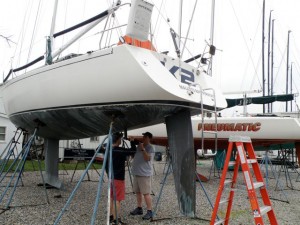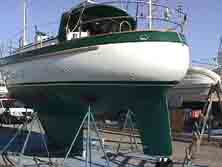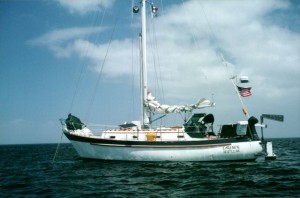Hey! Where’s our rudder?

One of the big differences between Earendil and Shearwater is the rudder design. A Valiant 32 has a skeg-hung rudder, while a J/120 has a semi-balanced spade rudder. From a sailing and performance perspective, the semi-balanced spade rudder wins every time. There is less drag due to the smaller surface area (no skeg) and lower loads on the helm due the semi-balanced configuration. The boat is more responsive both moving forward and in reverse. The one drawback of a spade rudder is the lack of protection. A skeg-hung rudder, when done properly as with the Valiant, provides protection to the rudder in the event of a collision with, oh, say a very large floating log in the Straits of Juan de Fuca. We’ve had that experience, and I’m of the belief that our very first voyage on Earendil would have ended before we even reached the ocean had our rudder not been protected against the HUGE submerged tree we hit. That said, construction and materials have advanced significantly in the 20 years between the build of Earendil and Shearwater. Nowadays, spade rudders are designed with the possibility of collision in mind. The composite rudder posts are larger in diameter. In fact, Bob Perry, the designer of the Valiant, regularly includes a spade rudder on his new designs, even those intended for bluewater cruising. So, things have improved, but still the possibility of losing the rudder, or losing steerage still exists. In the event of a loss of steering, we need a backup.
There are a number of ways we could go about providing a backup/emergency steering system on Shearwater, but I’ve narrowed the choices down to two, maybe three. I want a “real” backup, not an idea of various parts we would use aboard to fabricate a solution that probably wouldn’t work.
The first option would be to use a drogue, like the Galerider, towed astern, with lines led through blocks at the toe rail to the winches. This solution does work, in that it is possible to steer the boat generally in the direction you want to go, and we plan to have a drogue on board anyway for other reasons. The problem with a drogue is that it requires constant attention and adjustment of the lines to keep the boat on course. Not bad if you don’t have far to go, but with only 2 people onboard and the possibility of hundreds of miles to sail, it would get old real quick.
The second option is an SOS Rudder, manufactured by Scanmar International. This rudder borrows from the Monitor windvane. Brackets are pre-installed on the stern, and the assembly can be attached and placed into position at the time of need. The rudder is attached to an included tiller and away you go. This solution provides a solid steering mechanism and it can be stowed below when not needed (hopefully forever!). Like the drogue, though, the SOS rudder requires active steering to keep the boat on course. The SOS Rudder costs about $2,500.
The final option is a Hydrovane. This is neat piece of kit. The Hydrovane is a windvane self-steering device that can be converted to an emergency rudder in minutes. The concept of the Hydrovane is very similar to the Auto-Helm windvane we had on Earendil. In both cases the boat’s main rudder is locked in position, and the windvane steers the boat using the attached rudder. We were extremely pleased with the performance of our Auto-Helm wind vane. The only real drawbacks were some of the materials were not marine-grade, and the giant rudder had to be drug through the water all the time. It added drag, and you had to be very careful when backing up so as not to damage the rudder. The Hydrovane improves on both of these points. Unlike the Auto-helm the Hydrovane, it can be purchased with the emergency tiller option. I like the Hydrovane because it would be an effective self-steering device, a back-up to our NKE & Raymarine autopilots, and used without electricity. That might be a big plus, but I have a feeling that as long as the NKE pilot is working that is what we would use nearly all the time. I’m just not certain we would use the Hydrovane as a windvane which requires a big contraption strapped to the back of the boat, dragging through the water, that may never get used. Although, one benefit of this type of windvane is that even if we lost steering with the main rudder the Hyrdovane could self-steer unattended. The Hydrovane costs about $5,000.
To sum up, before July we need to choose some backup steering option. We could opt for the full-featured option of emergency steering plus a self-steering windvane, knowing that we may never use either. Or, we could choose the less expensive emergency rudder, which can be stowed below when not needed, costs significantly less, but does not provide a back-up self-steering device. Or maybe we just take our chances and plan to use the drogue as the emergency steering device?
For perspective a J/120, J-Fever, the second J/120 built, lost its rudder while racing in heavy weather. They successfully used a drogue to steer the boat back to the marina. The story is here. The surveyor who inspected the boat afterwards suspected that there had been an earlier rudder collision that eventually resulted in the loss of the rudder. Note that the maximum boat speed before the rudder failed was 20 knots! Of the over 200 J/120’s built, this is the only reported rudder failure I’ve found.
What would you suggest for our situation?
Sign up to receive blog updates



Leave a Reply